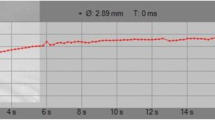Abstract
Purpose
To compare the retinal and choroidal microvasculature quantitatively via optical coherence angiography (OCTA) in children with attention deficit hyperactivity disorder (ADHD) who were under methylphenidate (MFD) treatment or newly diagnosed as ADHD and were not taking any medication.
Methods
This was a cross-sectional, comparative, and observational study. The children who were between 6 and 17 years old and previously diagnosed as ADHD and were under MFD treatment or who were newly diagnosed as ADHD were included in the study. Optical coherence tomography angiography imaging was performed via OCT RT XR Avanti with AngioVue software (Optivue Inc, Freemont, CA). The main outcome measure of the study was OCTA parameters of the children with ADHD.
Results
A total of 186 eyes of 186 patients were included in the study. There were 80 eyes in the control group (newly diagnosed) and 106 eyes in the treatment group (under MFD treatment). The mean duration of methylphenidate use in the treatment group was 33.9 ± 20.1 months (between 6 and 84 months). The choriocapillary flow area (p = 0.03), superficial parafoveal thickness (p = 0.01), and deep parafoveal thickness (p = 0.01) were statistically greater in the treatment group than the control group.
Conclusion
Most of the important OCTA parameters especially foveal avascular zone (FAZ) area and FAZ perimeter were similar in the two groups. There was a significant difference between the two groups in parafoveal thickness values which might point to a slight effect of MFD on retinal circulation.

Similar content being viewed by others
References
Grönlund MA, Aring E, Landgren M, Hellström A (2015) Visual function and ocular features in children and adolescents with attention deficit hyperactivity disorder, with and without treatment with stimulants. Eye 21:494–502
Bucci MP, Stordeur C, Septier M, Acquaviva E, Peyre H, Delorme R (2017) Oculomotor abnormalities in children with attention-deficit/hyperactivity disorder are improved by methylphenidate. J Child Adolesc Psychopharmacol 27:274–280
Bucci MP, Seassau M, Larger S, Bui-Quoc E, Gerard CL (2014) Effect of visual attention on postural control in children with attention-deficit/hyperactivity disorder. Res Dev Disabil 35:1292–1300
Pietrzak RH, Mollica CM, Maruff P, Snyder PJ (2006) Cognitive effects of immediate-release methylphenidate in children with attention-deficit/hyperactivity disorder. Neurosci Biobehav Rev 30:1225–1245
Duman NS, Duman R, Sarı Gökten E, Duman R (2017) Lens opacities in children using methylphenidate hydrochloride. Cutan Ocul Toxicol 36:362–365
Groen Y, Börger NA, Koerts J, Thome J, Tucha O (2017) Blink rate and blink timing in children with ADHD and the influence of stimulant medication. J Neural Transm 124:27–38
Larrañaga-Fragoso P, Noval S, Rivero JC, Boto-de-los-Bueis A (2015) The effects of methylphenidate on refraction and anterior segment parameters in children with attention deficit hyperactivity disorder. J AAPOS 19:322–326
Fried M, Tsitsiashvili E, Bonneh YS, Sterkin A et al (2015) ADHD subjects fail to suppress eye blinks and microsaccades while anticipating visual stimuli but recover with medication. Vis Res 101:62–72
Hagag AM, Gao SS, Jia Y, Huang D (2017) Optical coherence tomography angiography: technical principles and clinical applications in ophthalmology. Taiwan J Ophthalmol 7:115–129
Rodríguez FJ, Staurenghi G, Gale R, Vision Academy Steering Committee (2018) The role of OCT-A in retinal disease management. Graefes Arch Clin Exp Ophthalmol 256:2019–2026
Gołębiewska J, Olechowski A, Wysocka-Mincewicz M, Odrobina D et al (2017) Optical coherence tomography angiography vessel density in children with type 1 diabetes. PLoS ONE 20(12):e0186479
Yilmaz I, Ocak OB, Yilmaz BS, Inal A, Gokyigit B, Taskapili M (2017) Comparison of quantitative measurement of foveal avascular zone and macular vessel density in eyes of children with amblyopia and healthy controls: an optical coherence tomography angiography study. J AAPOS 21:224–228
Sobral I, Rodrigues TM, Soares M, Seara M et al (2018) OCT angiography findings in children with amblyopia. J AAPOS 22:286–289
Schwartz R, Sivaprasad S, Macphee R, Seara M et al (2018) Subclinical macular changes and disease laterality in pediatric coats disease determined by quantitative optical coherence tomography angiography. Retina. https://doi.org/10.1097/iae.0000000000002322
Sarwar S, Hassan M, Soliman MK, Halim MS et al (2018) Diurnal variation of choriocapillaris vessel flow density in normal subjects measured using optical coherence tomography angiography. Int J Retina Vitr 4:37
Roemer S, Bergin C, Kaeser PF, Ambresin A (2018) Assessment of macular vasculature of children with sickle cell disease compared to that of healthy controls using optical coherence tomography angiography. Retina. https://doi.org/10.1097/iae.0000000000002321
Tunc E, Erdogan D, Gozil R, Bahcelioglu M et al (2009) Dose-dependent immunohistochemical changes in rat cornea and retina after oral methylphenidate administration. Anat Histol Embryol 38:128–132
Acknowledgements
This cross-sectional study was not supported by any company. None of the authors has financial or proprietary interests in any material or method mentioned. These data have not been previously published.
Author information
Authors and Affiliations
Contributions
HNT, SY, TK, AMY, UY, AO: involved in design and conduct of the study; HNT, AO: preparation and review of the study; HNT, SY, TK, AMY, UY: data collection; and AO: statistical analysis.
Corresponding author
Ethics declarations
Conflict of interest
None of the authors has any conflicts of interest or competing interests regarding the materials used in the research.
Ethical approval
All procedures performed in studies involving human participants were in accordance with the ethical standards of the institutional and/or national research committee and with the 1964 Helsinki declaration and its later amendments or comparable ethical standards.
Informed consent
Informed consent was obtained from all individual participants included in the study.
Additional information
Publisher's Note
Springer Nature remains neutral with regard to jurisdictional claims in published maps and institutional affiliations.
Rights and permissions
About this article
Cite this article
Tarakcioglu, H.N., Yilmaz, S., Kara, T. et al. Foveal avascular zone and vessel density in children with attention deficit hyperactivity disorder. Int Ophthalmol 40, 1155–1162 (2020). https://doi.org/10.1007/s10792-019-01281-8
Received:
Accepted:
Published:
Issue Date:
DOI: https://doi.org/10.1007/s10792-019-01281-8




